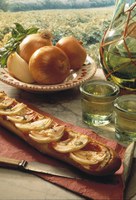Prairie Fare: Onions Add Flavor, Potential Health Benefits to Your Menu
(Click the image below to view a high-resolution image that can be downloaded)
By Julie Garden-Robinson, Food and Nutrition Specialist
NDSU Extension Service
“Mom, what’s wrong?” my daughter asked.
I was blinking hard, tears were running down my cheeks and my face was red as a tomato when I turned from the counter.
I think my daughter was expecting some kitchen catastrophe requiring a trip to the emergency room. I regained my composure in a couple of minutes and chopped the onions with extended arms.
“I’m cutting the onions I just picked from our garden and they’re really pungent!” I exclaimed.
I wasn’t expecting our relatively small garden-grown onions to be aromatic powerhouses. I also had not followed some of the usual “rules” for cutting onions.
I had cut off the top and the bottom end from the onion, then peeled and diced them. I knew better. Next time, I will remember some onion-cutting strategies to reduce tears.
I should have cut the top first and left the root end intact as long as possible. Many of the sulfur compounds, which can irritate your eyes, are concentrated at the root end. Chilling onions for at least 30 minutes also can help reduce the crying potential. Using a sharp knife is advised.
The National Onion Association has a video at http://tinyurl.com/stoptears that shows how to slice and dice an onion like a pro.
On average, most people consume about 20 pounds of onions per year. In fact, we are eating 70 percent more onions than we did just a few years ago.
Onions are among the foods I always have on hand in my house because we add them to kabobs on the grill, casseroles, stews, meatloaf, pizza, sandwich spreads, egg salad and fajitas. When sautéing onions, avoid using high heat because it can lead to bitterness.
Yes, on occasion, we indulge in some onion rings or even an “onion blossom” at a restaurant. Keep in mind that batter-dipped, deep-fried foods are high-calorie foods best left for an occasional treat.
Not only are plain onions low in calories and high in flavor, but they also are good for us. Onions provide vitamin C and fiber and just 45 calories per medium-sized onion. They contain phosphorus and potassium and antioxidant compounds including “quercetin” that protect our body from damage.
Some researchers are studying the potential role of onion consumption in helping prevent diseases such as heart disease, various types of cancer, bone disease and ulcers.
Many onion varieties are available, including yellow, red, white, purple, Spanish and Vidalia. When you select onions at the grocery store, look for onions without cuts or bruises because damaged produce will have a shorter shelf life.
Store unpeeled onions in a cool, dark place with plenty of airflow. Do not keep them in a plastic bag. Once you have peeled and cut the onions, store them in your refrigerator in a sealed container and use them within a week.
If you have more onions than you can use, consider freezing them. Simply, peel, wash, chop and blanch in boiling water for 90 seconds. Then cool them in an ice bath and pack in recipe-sized amounts in freezer bags or containers. Frozen diced onions work well in cooked dishes such as soups.
What about the “onion breath?” Try nibbling on fresh parsley, drink lemon water or chew some gum. You can do what we do in my house: Hang around with people who ate the same food.
Here’s a delicious Italian-inspired recipe courtesy of the National Onion Association (http://www.onions-usa.org/).
Crusty Onion Bruschetta
1 French bread baguette (about 8 ounces)
4 ounces light cream cheese
1/2 c. nonfat or low fat ricotta cheese
2 tsp. dried oregano
2 tsp. dried basil
1 c. pizza sauce, canned
1 medium onion, cut into paper-thin wedges
1/4 c. Parmesan cheese, grated
Parsley flakes (optional)
Split bread in half lengthwise. Pull out some bread from center of each half, leaving a 1/2-inch shell. Beat cheeses and herbs with fork and spread mixture along length of both bread halves. Place a ribbon of pizza sauce and a single layer of onions over cheese mixture. Sprinkle with Parmesan and bake on baking sheet at 400 degrees for 30 minutes or until onion is tender and tips are slightly blackened, but crust is not too dark. Sprinkle with dry parsley flakes if desired. Cut crosswise into narrow strips.
Makes eight servings. Each serving has 190 calories, 4 grams (g) of fat, 8 g of protein, 30 g of carbohydrate, 2 g of fiber and 530 milligrams of sodium.
(Julie Garden-Robinson, Ph.D., R.D., L.R.D., is a North Dakota State University Extension Service food and nutrition specialist and professor in the Department of Health, Nutrition and Exercise Sciences.)
NDSU Agriculture Communication – Oct. 16, 2014
| Source: | Julie Garden-Robinson, (701) 231-7187, julie.garden-robinson@ndsu.edu |
|---|---|
| Editor: | Rich Mattern, (701) 231-6136, richard.mattern@ndsu.edu |


